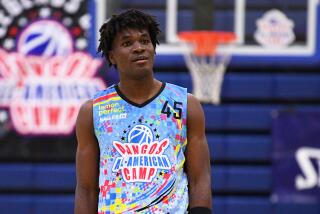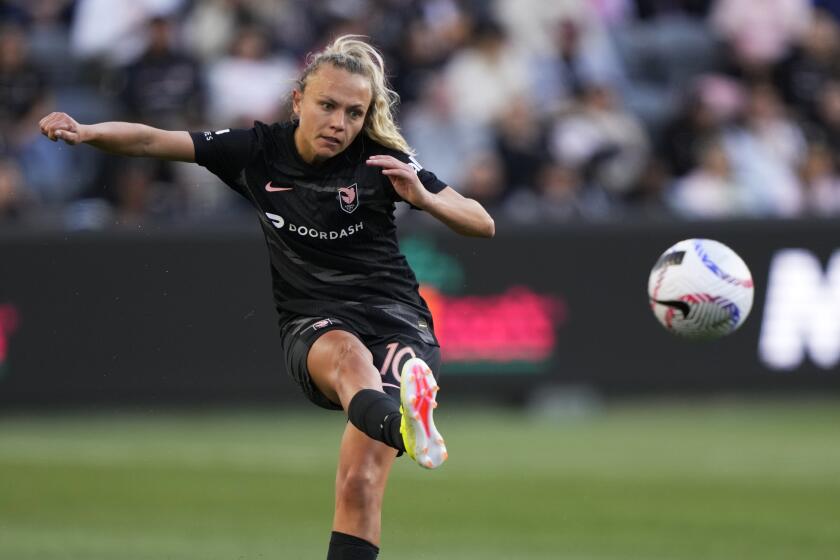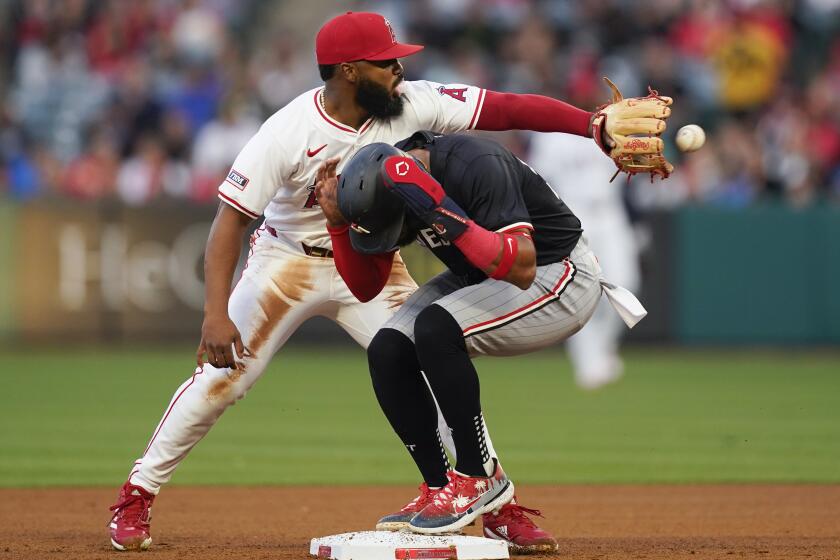Satellite camps bring college football recruiting close to home
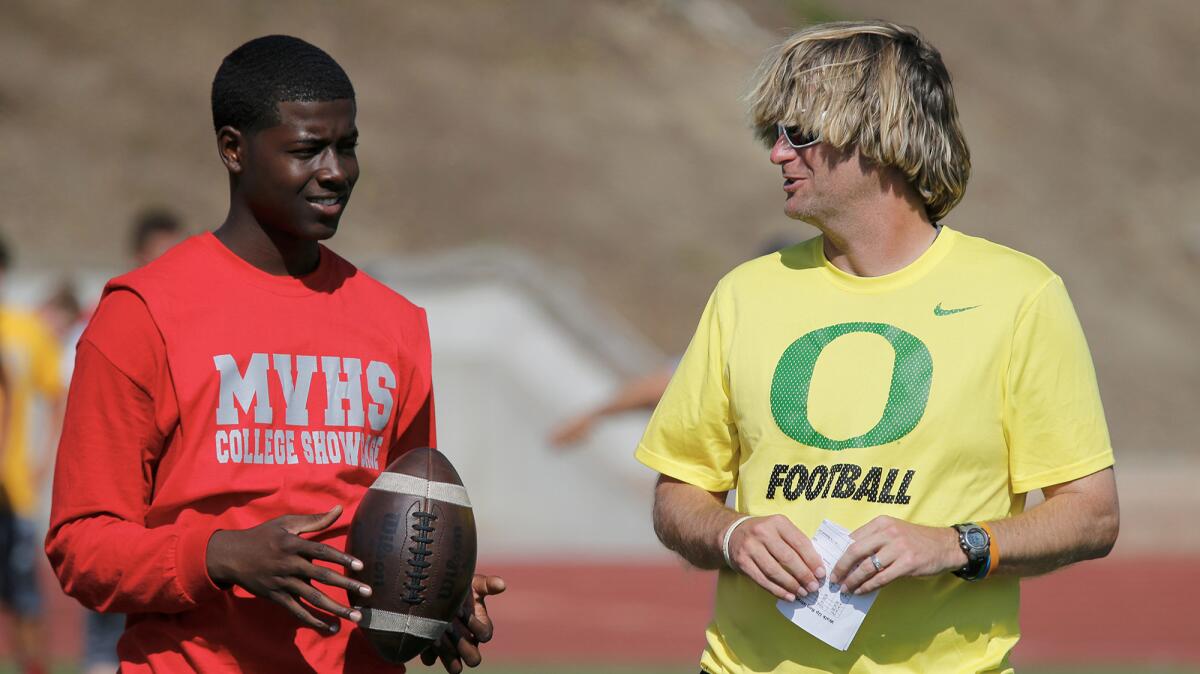
They lounged in the bleachers, about 150 strong. Some tall and sinewy, wearing confident smiles. Others short and pudgy, looking a bit apprehensive. All of them high school football players, their various team colors clashing into a sort of rainbow.
Antonio Pierce gazed up at them and scowled. The broad-chested former New York Giants linebacker sensed a lack of energy.
“Dude, go turn that music up,” he instructed a man wearing a Long Beach Poly High football polo. “We have to get these kids ready!”
When the music got louder — a scratchy version of “Straight Outta Compton” filling a stadium squeezed between academic buildings and a residential neighborhood — some of the players began bobbing their heads. Others started tossing a football around. A few remained still, staring straight ahead, letting headphones provide a personal warmup soundtrack.
They had all come to Long Beach Veterans Stadium on a Sunday evening in June for the same reason: to showcase their talents at what has become known in college football lexicon as a satellite camp. Staffers from Arizona, Boise State and Texas A&M, including Aggies Coach Kevin Sumlin, had traveled to the camp to mentor and evaluate players hoping to earn a scholarship to play at the next level.
A few of those players would be watched closely. Most wouldn’t be watched at all. There were only so many eyes on the field, so many college roster spots to fill and so many reps to go around.
At 5:55, Pierce ushered the players to the center of the field, took a place in front of the group and drew a deep breath. He pointed to where each drill would be. Then he let loose with a few age-old coaching cliches about competing, giving their best effort and showing the coaches all they had.
“Most importantly…” Pierce hollered, letting the two words hang in the air for a moment.
Were he an NCAA administrator, most important would be that no coach or player break compliance rules. Were he a parent, most important would be that his son performed well enough to attract a scholarship offer. Were he a college coach on a one-shot visit to this hotbed of talent, most important would be to steal a blue-chip recruit from the region. Conversely, were he a local college coach, most important would be to keep the Los Angeles talent home.
This is the conundrum of satellite camps, a trend in recruiting that blitzed Southern California with more than a dozen events this month.
Pierce, who won a Super Bowl with the Giants and now is Long Beach Poly’s director of operations, chose to keep his last directive simple.
“... have fun!” he ordered, just before bringing the players into a massive huddle.
“Hard work!” the group shouted after a count to three, then scattered in different directions to chase a similar dream.
::
On another day in June, Arizona Coach Rich Rodriguez stood in the middle of a sunlit field at Los Angeles Hawkins High and watched players sweat through positional drills.
Two days earlier, coaches from USC, UCLA and Eastern Washington used the same space for the same purpose. Six days before that, California Coach Sonny Dykes and Tennessee Coach Butch Jones navigated the same turf. And on a later date, Michigan Coach Jim Harbaugh would make the Hawkins field the 37th stop in his exhaustive coast-to-coast satellite camp tour.
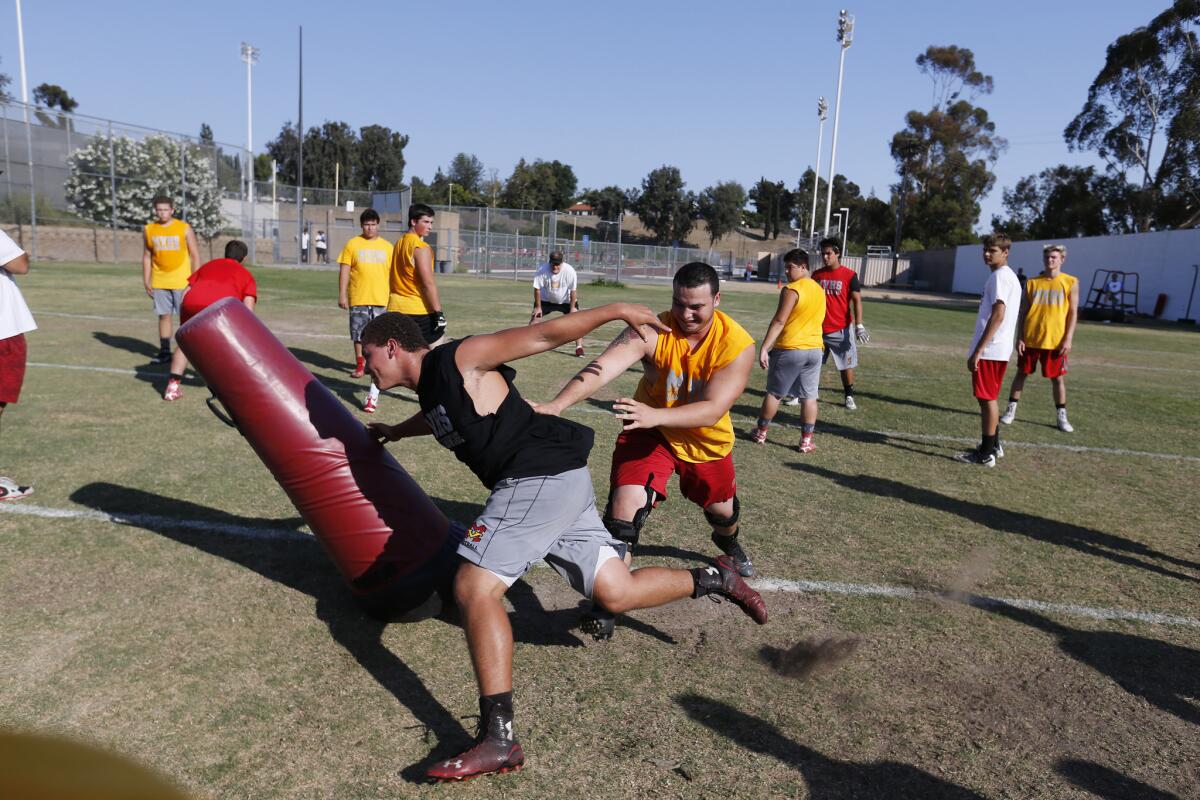
High School football players participate in a drill as the Oregon and Mission Viejo High School coaching staffs look on during a satellite camp.
“If there were no satellite camps right now, what would a student-athlete be doing?” Hawkins Coach Milvon James said at the Arizona camp. “He might be working out, but no coach would be able to see him.”
Michigan’s coaching staff has led the charge to embrace the opportunity, but there is continued debate over the camps — amplified by the differing opinions of the outspoken Harbaugh and Nick Saban, the coach of reigning national champion Alabama and critic of a situation he said could turning recruiting into “the wild wild West.”
The Times visited five camps over 10 days to learn more about the people who run them and the players who populate them.
Satellite camps are clinics set up by high schools, small colleges and other organizations that allow players to be instructed and evaluated by major college coaching staffs that otherwise would be prohibited by NCAA rules from holding camps outside a 50-mile radius of their campuses. They became a hot topic in April when a council of Division I representatives banned them, only to have a higher-ranking board of university chief executive officers rescind that decision a few weeks later.
In the wake of the reversal, top-level coaches traveled for camps at record rates this summer. The Southeastern and Atlantic Coast conferences, which had previously prohibited their coaches from attending the camps and fought for a nationwide ban, joined the fray to avoid giving other conferences an edge.
The camps are attractive to high school players because they save time and money. Rather than traveling to attend camps at individual colleges, they can display their talents near home and in front of coaches from several universities at once.
The camps are attractive for colleges because NCAA rules prohibit potential recruits from making official visits to campuses until the fall of a player’s senior year. Staffing a camp allows the college team to bring a coach and its program philosophy directly to a player of any age, and see players who might otherwise go unseen.
The tricky part of the situation: Coaches attending camps hosted by another school or third party are not allowed to recruit during the event, according to the NCAA, which told The Times in an email that its enforcement staff would attend more than 60 satellite camps around the country this month.
Another worry for some coaches — Saban among them — is the involvement of third parties, other than a player’s high school coach, during the recruiting process.
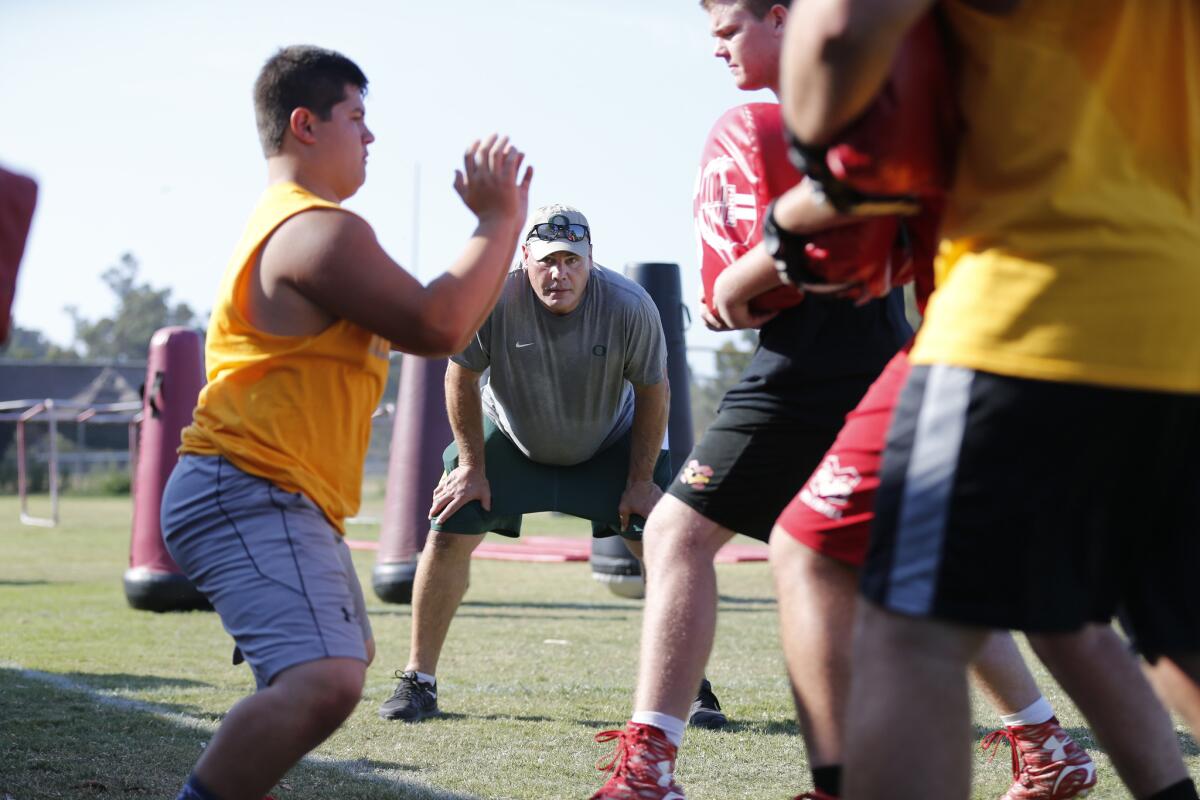
Oregon offensive line coach Steve Greenwood, center, watches high school football players run through drills during an Oregon satellite camp held at Mission Viejo High School.
During the SEC’s spring meeting, Saban pointed to NCAA rules against recruiting through third parties and said, “that’s exactly what you’re doing,” at some satellite camps. He also expressed skepticism about other aspects of the situation, noting there was no way for a coach to know that a camp organizer wasn’t representing a certain player or players and “who even knows if the guy paid to go to the camp?”
USC, including Coach Clay Helton, attended satellite camps from Honolulu to Tampa — and 11 places between — this summer. UCLA has sent assistant coaches to about a dozen camps, mainly on the West Coast.
“I know it’s not for recruiting and that kind of stuff, whatever they’re saying, but at the end of the day it just elongated the evaluation period,” said Demetrice Martin, the Bruins’ defensive backs coach, who attended camps in Los Angeles, Whittier and Norco.
Martin considers his time well spent if he discovers one or two players he was not previously aware of.
“When we have our camps here at UCLA, we find one or two … it’s a success,” he said. “If I find one or two at each satellite camp, it’s a success, so I guess it’s about volume. The more you go to, the more one or twos you find.”
::
Savon Scarver had traveled far. Now he was traveling fast.
The senior to be, from a high school in Las Vegas, drove to Rialto High so he could show off his skills to coaches from UCLA, Washington State and New Mexico.
The wide receiver had already attracted scholarship offers from Nevada and Nevada Las Vegas, but he wanted more. So, even after he was clocked covering 40 yards in 4.37 seconds, he lined up again like the state champion hurdler he is and sprinted toward the outstretched stopwatches one more time.
The times: 4.34, 4.43 and 4.33.
While Scarver went through drills later in the camp, Eric Yarber, UCLA’s wide receivers coach, talked with the teen’s family in the stands.
Other players, though equally committed, are still trying to get noticed.
Jerman Gotoy, a rising senior who played quarterback last season for Los Angeles Dorsey High, had already attended 12 satellite camps — as near as Hawkins and as far as Tennessee — this summer. None of the trips earned him an offer.
“To me, the camps are beneficial because he needs to get a look,” said Lorene Hackett, Gotoy’s mother. “You want them to have that dream.”
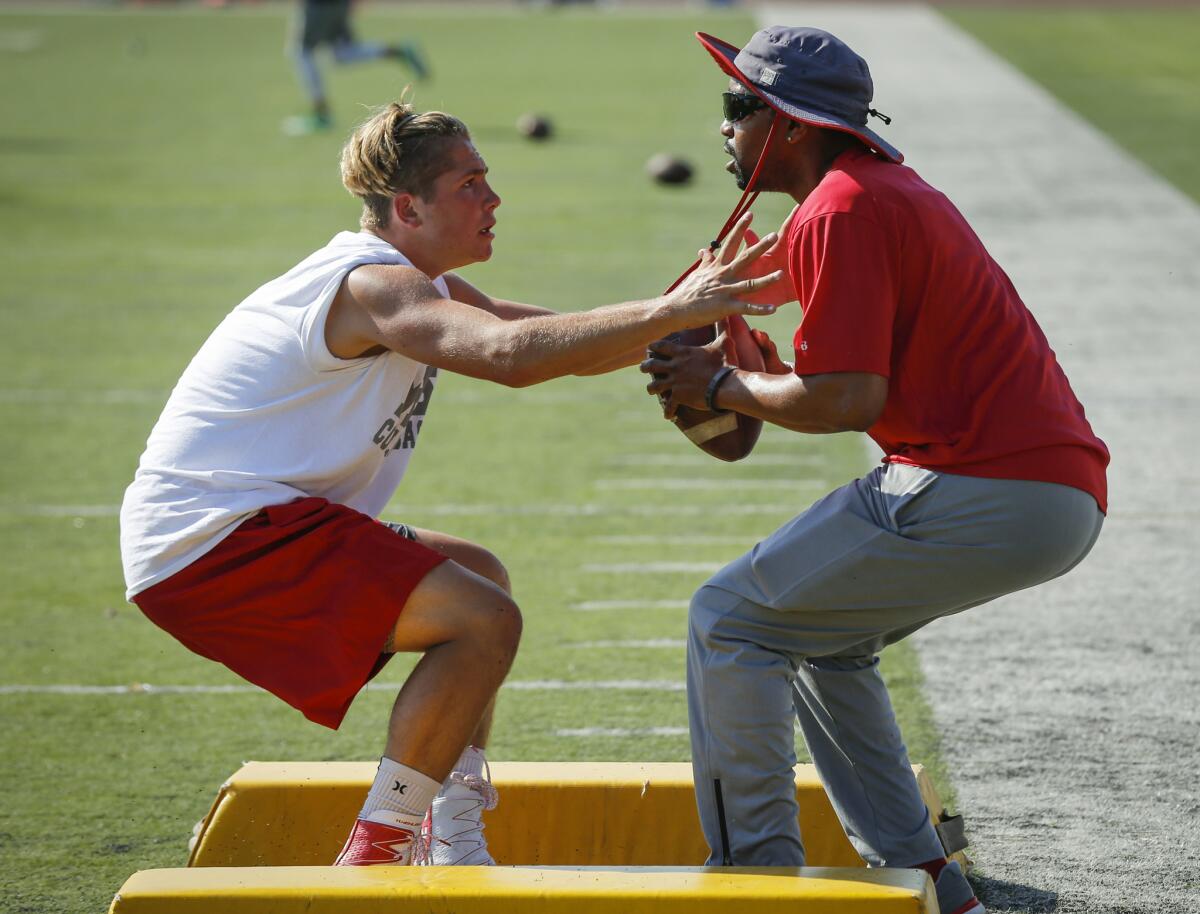
Mission Viejo High School defensive backs coach Robert Lee, right, runs drills with a high school player during a satellite camp featuring coaches from the University of Oregon.
The idea of unearthing diamonds in the rough at satellite camps is appealing to coaches, players and parents alike. But the rough pay as much for the camps as the diamonds do, leading critics to accuse organizers of profiting off unrealistic hopes.
The cost of satellite camps typically range from $25 to $200. At the event held at Veterans Stadium, 150 players each paid $40; Pierce said any profit went to Poly’s football program.
At an Oregon camp at Mission Viejo last week, the cost was $40 per player, which camp organizer Garrett Gray said would barely cover expenses.
Gray, Mission Viejo’s wide receivers coach, has run a satellite camp the last three summers. This year, he said he advertised door-to-door to hundreds of players, filled out paperwork for Oregon’s compliance office and required campers to sign liability waivers approved by the NCAA. As a result, 96 players were able to meet Ducks staffers without traveling to Eugene.
Organizers promote the personal access the camps offer.
“I heard a coach say earlier that he liked a player because he was coachable,” said Chris Love, who organized the satellite camp in Rialto. “Coachable. You can’t see coachable from a 40-yard dash time on an [Internet recruiting] page.”
Jeremiah Criddell, who will be a sophomore at Rancho Cucamonga High in the fall, has no varsity tape to show college coaches. But when he heard classmates saying Oregon State and Utah State were coming to campus for a satellite camp, he asked his mother to cover the cost and then prepared to showcase his skills as a defensive back.
Criddell started playing football only two years ago, but his mom drove him to Sacramento for one camp, to Corona Centennial for another and then came up with $35 to pay for the camp at his own school.
It was a wise investment. At the end of the day, he received a scholarship offer from Utah State.
When Criddell told his mom, they both cried.
::
By the time the Long Beach camp wrapped up around 8:40 p.m., the field’s lights only partially illuminated an otherwise dark parking lot.
But as headlights started to flick on, parents and players noticed something tucked under each car’s windshield wiper.
It was a flyer advertising another satellite camp in three days.
UCLA would be there, it said. It promised college guidance counseling and two free SAT prep classes for every attendee. It promised “instruction from top universities.”
It promised another chance.
Staff writers Lindsey Thiry and Zach Helfand contributed to this article.
renee.griffin@latimes.com; Twitter: @ReneeMGriffin
jesse.doughtery@latimes.com; Twitter: @dougherty_jesse
More to Read
Get our high school sports newsletter
Prep Rally is devoted to the SoCal high school sports experience, bringing you scores, stories and a behind-the-scenes look at what makes prep sports so popular.
You may occasionally receive promotional content from the Los Angeles Times.

